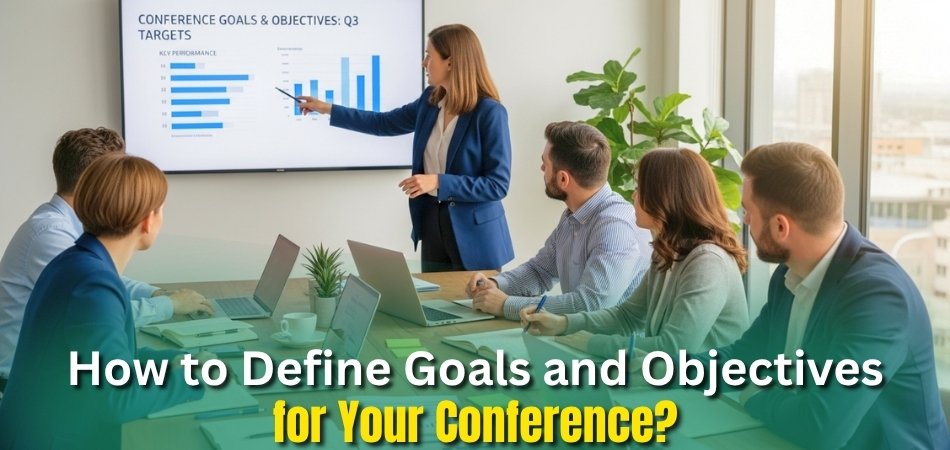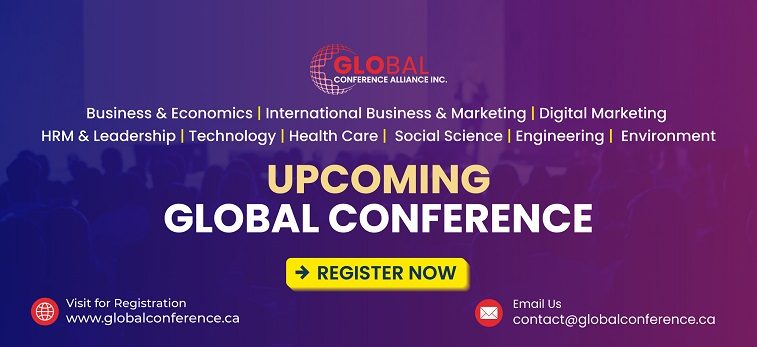Planning a conference is exciting, but it can quickly feel overwhelming without a clear direction. Whether you’re aiming to inspire, educate, or connect people, knowing exactly what you want to achieve makes all the difference. That’s where defining goals and objectives comes in; they’re the foundation for every successful event.
If you’re wondering how to define goals and objectives for your conference, start by asking why you’re hosting it. Set broad goals like growing your brand or creating connections, then break them into SMART objectives: Specific, Measurable, Achievable, Relevant, and Time-based. Write them down and track progress often.
Follow the rest of this article to learn how to turn your ideas into actionable plans that truly deliver results.
How to Define Goals and Objectives for Your Conference?
Great events start with clarity. This guide shows you how to set strong goals and sharp objectives for your conference. You will move from big ideas to specific targets with simple steps. Read on to plan smarter, measure what matters, and keep your team focused from start to finish today.

Step 1: Clarify your why
Begin with the core purpose. Ask what problem you solve or what chance you create. Name the desired change for attendees, such as new skills or fresh leads. Let this purpose steer every choice.
Step 2: Know the audience and stakeholders
List who you serve and who helps you. Capture needs, budgets, and success signals. Confirm how each group defines value. Build your plan around those signals.
Step 3: Draft 3–5 big goals
Write bold, high-level aims. Tie each goal to your mission. Keep goals inspiring yet realistic. Avoid vague phrases and choose crisp language.
Step 4: Turn goals into SMART objectives
Translate each goal into clear steps. Make them Specific and Measurable. Keep them Achievable, Relevant, and Time-bound. Set deadlines and exact numbers.
Step 5: Select KPIs and baselines
Pick metrics that prove progress. Use signups, session ratings, leads, or sponsor wins. Record last year’s numbers to set fair targets. Track the same metrics all season.
Step 6: Match objectives to tactics
Choose actions that hit the numbers. Map sessions, formats, and outreach to each target. In the United States, many hosts plan conferences in USA, and others choose the UK, Germany, or Singapore. Let location, agenda, and marketing support the goals.
Step 7: Align the team and partners
Share goals and objectives with everyone. Invite sponsors and speakers to refine KPIs. Assign clear owners and due dates. Confirm budgets and tools on day one.
Step 8: Document, share, and review
Place the plan in a shared hub. Keep one page per goal with its objectives and KPIs. Note risks and fixes. Update the document after each milestone.
Step 9: Measure, learn, and adapt
Open dashboards weekly. Compare results against targets. Fix gaps fast with focused tests. Keep what works and drop what drags.
Examples of Goals and Objectives
Here’s a table with common conference scenarios, illustrating goals and corresponding SMART objectives:
| Scenario | Goal | SMART Objective Example |
| Networking-Focused Event | Build industry connections | Host 10 targeted networking sessions resulting in at least 300 exchanged business cards by event close. |
| Educational Conference | Educate attendees on trends | Deliver 15 workshops with 80% of participants reporting improved knowledge via post-event surveys within one week. |
| B2B Marketing Summit | Generate leads | Secure 50 qualified leads through booth interactions and follow-up emails, measured by CRM entries within 30 days post-event. |
| Fundraising Gala | Raise funds for a cause | Collect $100,000 in donations and pledges during the event, tracked via real-time donation software. |
| Brand Awareness Launch | Increase visibility | Achieve 1 million social media impressions and 500 media mentions within two weeks after the conference. |
Why Are Goals and Objectives Important for a Conference?
Hosting a conference without direction can feel confusing and chaotic. Goals and objectives bring focus, structure, and purpose to every part of your event. They help organizers make smart decisions, track success, and create meaningful experiences that truly connect with the audience. Here are why they are important for a conference.
Give Your Event a Clear Direction
- Goals guide every action and keep your team focused on one vision that drives meaningful outcomes and attendee satisfaction.
- Clear objectives create a straight path from planning to execution, ensuring each task directly supports your final purpose.
Strengthen Team Coordination
- When everyone understands the same goals, communication becomes easier and collaboration feels more natural across departments and partners.
- Shared objectives encourage accountability, helping teams monitor their performance and celebrate progress together without losing motivation.
Improve Decision-Making
- Defined goals help you choose event formats, speakers, and marketing channels that truly serve your conference’s primary purpose.
- Objectives work as filters for every choice, preventing distractions and keeping the event aligned with measurable achievements.
Attract Sponsors and Stakeholders
- Sponsors are more likely to invest when they see structured objectives and a clear roadmap toward specific, trackable success.
- When stakeholders understand your measurable targets, they feel more confident in supporting your event financially and strategically.
Enhance Attendee Experience
- Clear goals help design content that resonates deeply with participants, ensuring every session meets their expectations and needs.
- Objectives allow organizers to track engagement levels, adapt quickly, and make sessions more interactive and valuable for attendees.
Measure Success Effectively
- With goals in place, you can set key performance indicators that show real progress instead of vague assumptions.
- Defined objectives allow teams to analyze data, refine strategies, and confidently report measurable outcomes after the event concludes.
Boost Long-term Growth
- Achieving conference goals builds credibility and strengthens your brand identity for future events within your industry.
- Learning from results helps refine future objectives, creating continuous improvement and sustained success across multiple conferences.
Maintain Focus Under Pressure
- When unexpected issues arise, goals serve as steady anchors, guiding quick decisions that protect your overall mission.
- Objectives: keep the entire team calm and purposeful, ensuring effort remains concentrated on what truly matters most.
What’s the Difference Between Conference Goals and Objectives?
Here’s a clear and easy-to-read table showing the difference between conference goals and objectives:
| Aspect | Conference Goals | Conference Objectives |
| Definition | Broad, overarching statements that describe the overall purpose of your conference. | Specific, measurable actions or milestones that help achieve the broader goals. |
| Focus | Concentrates on what you want to achieve in the long term. | Focuses on how you will achieve it through concrete steps. |
| Scope | Wide and strategic, setting the vision for the event. | Narrow and tactical, detailing precise actions to take. |
| Timeframe | Long-term — often applies to the entire event or future ones. | Short-term — focuses on tasks or milestones during planning and execution. |
| Measurement | Difficult to measure directly since it’s more qualitative. | Easy to track and evaluate with data, numbers, or KPIs. |
| Purpose | Provides inspiration, direction, and motivation for your team and stakeholders. | Ensures accountability, progress tracking, and clear performance indicators. |
| Example | “Build strong industry connections and increase brand recognition.” | “Facilitate 300 networking meetings and grow social media mentions by 25%.” |
| Outcome | Represents your desired end result or vision. | Represents the practical steps that lead to achieving that result. |
Conference goals represent your destination – the big vision that inspires your event, while the objectives are the roadmap that helps you reach it. When both work together, along with thoughtful planning and creating effective conference schedules, your event becomes purposeful, organized, and results-driven, setting the stage for success every single time.
Common Mistakes to Avoid When Setting Conference Goals
Setting strong conference goals sounds simple, but many planners fall into easy traps that hurt their event’s success. Poor focus, unclear priorities, or unrealistic aims can make even great ideas fail fast. Understanding what not to do saves time and stress. Here are the key mistakes you should always avoid:
- Vague Purpose: Unclear goals confuse the team and reduce motivation when tasks lack meaning or direction. Define your main purpose clearly to guide decisions effectively.
- Too Many Goals: Setting several targets at once spreads effort thin and weakens outcomes across areas. Focus on three strong priorities that drive success confidently.
- Ignoring Audience Needs: Planning without knowing attendees’ interests leads to weak engagement and poor satisfaction. Research their expectations before shaping any conference direction carefully.
- Unrealistic Expectations: Overreaching targets frustrate teams and waste money when they can’t deliver. Build goals around real data, capacity, and available resources thoughtfully.
- Skipping Measurable Metrics: Without clear numbers, progress stays invisible and improvement feels random. Always add measurable criteria to track success and evaluate outcomes properly.
- Lack of Team Involvement: Goals built alone miss diverse insights and shared commitment. Invite key members early to align visions and strengthen accountability across departments.
- Forgetting Flexibility: Sticking to rigid plans blocks quick adjustments during changes. Leave room for updates to stay responsive and handle challenges efficiently.
- Poor Communication: When updates don’t reach everyone, teams drift apart and lose focus. Hold regular meetings and use shared tools to maintain clarity.
How to Track and Measure Conference Goal Achievement?
Tracking and measuring your conference goals might sound tricky, but it’s easier than you think. When you know what to look for, you can actually see if your event is doing well. Good tracking helps you learn what worked and what didn’t. It also helps you make your next event even better and more fun.
Set Clear Targets
Start by writing down exactly what you want to achieve. Maybe you want a certain number of attendees or social media mentions. When you set clear targets, it’s easier to see if you reached them. Keep your goals simple and realistic so everyone on your team understands them easily.
Use Attendance Data
Count how many people came to your event. Compare that number to the goal you set before the conference. If fewer people showed up, think about why and plan improvements. Tracking attendance helps you see if your promotion and outreach worked well.
Check Feedback Forms
Ask people what they thought about the event. Use short surveys or feedback forms to collect honest answers. Look for patterns—what people liked and what they didn’t. This information helps you improve future conferences and fix weak areas quickly.
Track Social Media
Keep an eye on how your event performed online. Count likes, comments, shares, and tags during the conference days. If your event hashtag was used a lot, it means people were excited. Social media is a great way to measure real engagement and buzz.
Monitor Speaker Sessions
Pay attention to which sessions had the most people or the longest attendance time. Speakers who draw big crowds usually connect well with your audience. Collect short feedback for each session to learn what worked best. This helps in choosing better speakers next time.
Measure Networking Success
Conferences are all about people meeting and connecting. Count how many business cards were exchanged or online connections made. You can also use event apps to track networking activity. Strong networking means your event met its purpose of bringing people together.
Review Finances
Look at your budget after the event ends. Compare what you spent and what you earned from ticket sales or sponsors. This helps you see if your goals made sense financially. Understanding money results helps you plan smarter for your next conference.
Tips to Keep Your Team Focused on the Conference Objectives
Keeping your team focused on conference objectives takes effort, communication, and clarity. When everyone knows the plan, teamwork feels easier and more productive. Use these simple, smart tips to keep your group aligned and motivated from start to finish.
Share a Clear Vision
- A clear vision gives everyone something to aim for and keeps the team moving in one direction together.
- When people know the event’s big goal, they stay motivated and understand why every task really matters daily.
Set Realistic Targets
- Breaking large goals into smaller, achievable tasks makes progress easier to track and keeps everyone motivated longer.
- Each short-term target should feel reachable and meaningful so the team doesn’t lose focus or energy midway.
Communicate Often
- Regular check-ins help catch problems early and prevent confusion between departments, saving time during critical deadlines.
- Open chats or weekly meetings encourage teamwork, making everyone feel heard and appreciated for their ideas consistently.
Encourage Team Involvement
- Let team members share their opinions when setting objectives; this builds ownership and keeps them more responsible overall.
- Involving people in decisions makes them feel connected to results and keeps energy levels higher throughout planning stages.
Align With Conference Purpose
- Keeping everyone aware of the bigger picture starts with understanding conference purpose and how each role contributes meaningfully.
- Once team members see how their work supports goals, they stay committed, focused, and proud of every completed milestone.
Celebrate Small Wins
- Recognize achievements often because appreciation boosts morale and inspires stronger dedication toward upcoming conference tasks quickly.
- Celebrating progress reminds your team that their hard work matters, strengthening unity and motivation before the final event arrives.
Provide Helpful Tools
- Use planning apps, task boards, or trackers to help your team stay organized and meet objectives more efficiently.
- Simple digital tools reduce confusion, share updates faster, and make collaboration smoother between departments and partners involved.
Offer Support and Guidance
- Be present for your team by listening, guiding, and helping when challenges or confusion arise during tough phases.
- Encouraging words and honest feedback build trust, helping everyone stay calm, confident, and ready to tackle obstacles easily.
Frequently Asked Questions
Defining clear goals and objectives is the foundation of a successful conference. It helps you stay organized, make smart decisions, and measure success properly. Below are eight frequently asked questions (FAQs) with simple, clear answers to guide you through the process.
Why Do Conferences Need Both Goals and Objectives?
Goals show the bigger purpose, while objectives break those ideas into small, measurable actions. Having both keeps your event balanced, focused, and easy to manage throughout every stage of planning and execution.
How Early Should I Define My Goals?
You should set your goals at the very beginning of your planning process. Doing this helps every decision—like speakers, sponsors, and promotion—fit your purpose clearly and save time later.
Who Should Help Set the Conference Goals?
Include your event team, sponsors, and main partners when defining goals. Getting different opinions ensures your goals match everyone’s expectations and create stronger collaboration from the start.
What Makes a Goal Effective?
An effective goal is clear, realistic, and connects directly to your conference’s purpose. It should inspire the team but also be specific enough to guide practical planning and daily actions.
How Can I Measure Conference Objectives?
Use simple numbers like attendance, engagement, feedback, or sponsorship results. These measurable details make it easier to track performance and see if you’re reaching your planned objectives successfully.
How Do SMART Objectives Help Conference Planning?
SMART stands for Specific, Measurable, Achievable, Relevant, and Time-based. Using this method keeps your objectives clear, trackable, and realistic, making it much easier to measure progress correctly.
Can Goals Change During Planning?
Yes, goals can change if new opportunities or challenges appear. Adjusting them helps your conference stay flexible and ensures every decision still supports your main vision effectively.
What Happens If Goals Aren’t Clear?
When goals are unclear, your team may lose direction, and the event can feel disorganized. Clear goals keep everyone focused, improve teamwork, and help you achieve a conference that runs smoothly and successfully.
Concluding Thoughts
A great conference happens when you know what you want to achieve and how to reach it. Clear goals and simple steps help your team stay focused and work better together. Learning how to define goals and objectives for your conference makes planning easier and keeps everything on track.
When you measure progress, adjust your plans, and celebrate small wins, your event becomes smoother and more successful. Every clear goal turns effort into real results. With teamwork, focus, and good planning, your conference will not only run well but also leave a strong and lasting impression.







